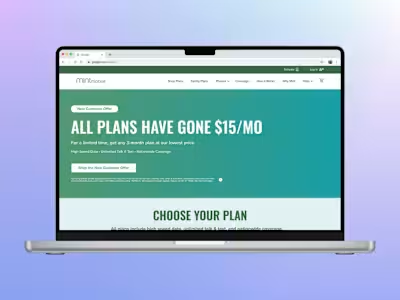Custom E-Commerce Flow for Performing Arts Nonprofit
Empowering concertgoers in San Diego to customize performing arts subscription packages
Picture this
A small performing arts non-profit just built the best concert hall on the west coast, but hasn’t updated their website in nearly a decade. I led a full-scale redesign that enabled online ticketing and a custom package flow for La Jolla Music Society, which helped us exceed subscription revenue goals by over $200,000 (68%).
Impact
Hit 168% of subscription revenue goal
30% increase in single ticket revenue
60% of subscribers moved online
The gist
During a full-scale website redesign, we enabled online ticketing, season subscriptions, and donations for La Jolla Music Society. This case study focuses on the “Compose Your Own” package flow, which helped us exceed subscription revenue goals by 68% (over $200,000) in the first post-launch season.
A genuine institution
In 2018, after over 50 years presenting and producing performing arts in San Diego, La Jolla Music Society had finally moved into its own, state-of-the-art, acoustically perfect concert hall, The Conrad. The non-profit needed to bring its website, which hadn't had UX/UI updates in nearly a decade, into the 21st century and refine the digital brand to reflect the world-class artists that it hosts.
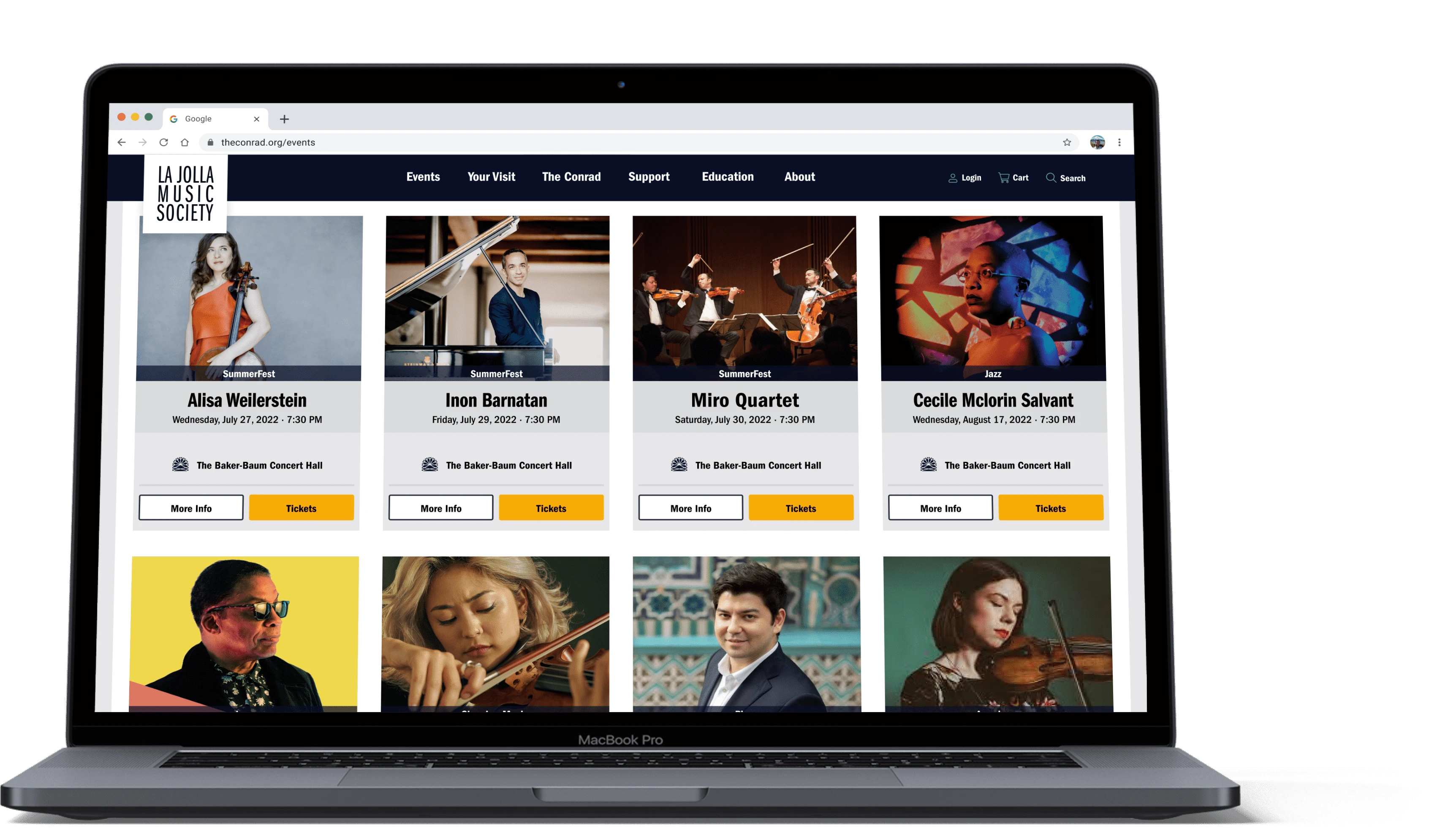
event listing page
Get them coming back for more
Project goals
Convert “single-ticket” (really single-event) buyers to multi-event buyers.
Find new ways to attract new audiences and retarget one-off attendees, converting them into long-term supporters.
Increase overall ticket revenue and subscriptions.
Solving for an antiquated, rigid system
User problems
No financial benefit to purchasing multiple concerts (outside of curated, genre-specific subscriptions).
No flexibility in the subscription programming for genre-agnostic ticket buyers.
Concertgoers couldn’t purchase season subscriptions online.
Business problems
Concertgoers could only subscribe through the box office by visiting in person, calling, or returning the form by mail, which still required phone calls. This placed a large burden on customer service staff at the beginning of each season.
LJMS was struggling to bring single-ticket concertgoers into the subscription pipeline.
LJMS was struggling to bring in younger audiences and ensure the long-term success of the organization—the average age of attendees is 62.
LJMS was not meeting subscription sales goals, which placed an immense burden on the fundraising team to cover the gap in organizational revenue.
Constraints
The redesigned website was launched immediately after the COVID shutdowns, when in-person events were just starting up again, which required new disclaimers and event rules.
The majority of patrons are not tech-native and require high levels of onboarding.
Limitations in design and functionality of Tessitura & TNEW, LJMS' CRM and ticketing API.
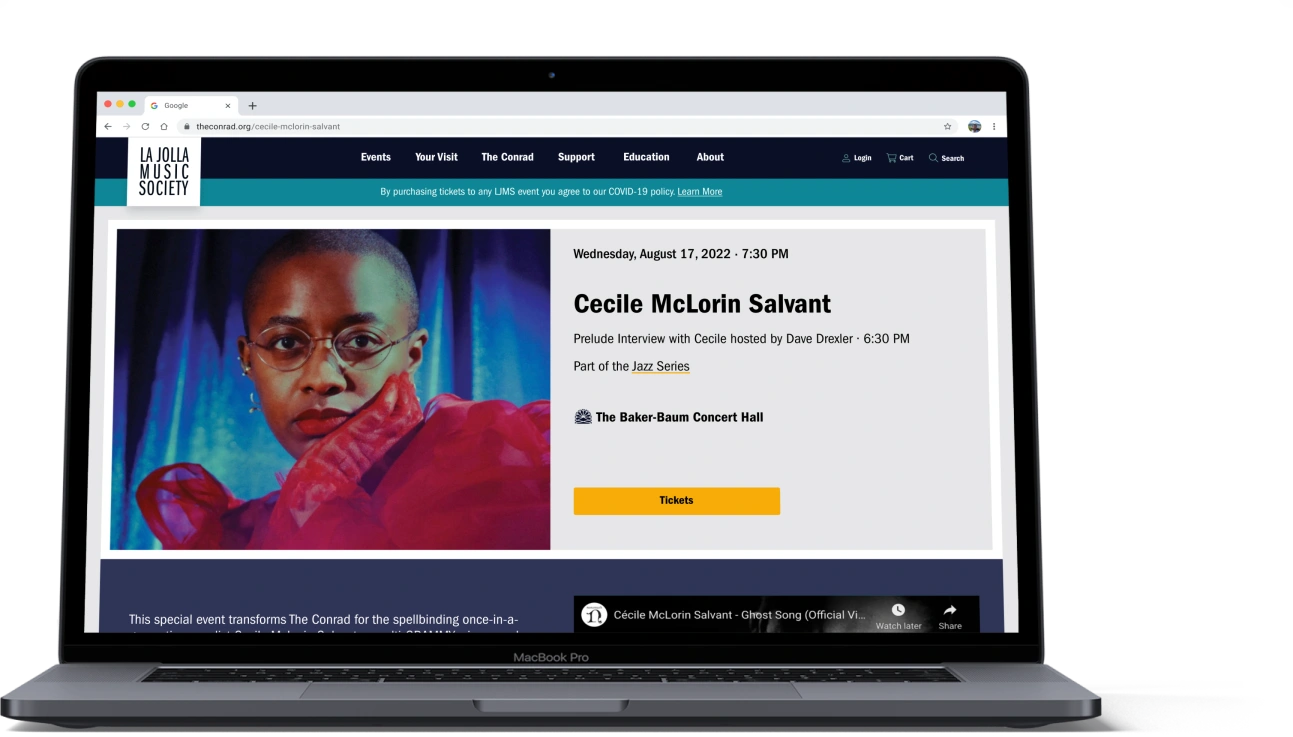
Event Detail Page
Desperate for a facelift
Adam, the Director of Marketing, launched LJMS’ website redesign in the autumn of 2019. The current iteration of the website was built in around 2010. It was full of bugs, had confusing and inaccessible UX, and patchwork fixes that regularly broke or crashed the site. The organization was well overdue for a refresh.
Who said we’re one-note?
Satisfying genre-agnostic arts lovers
During the research phase of the website redesign, I learned from data analysis, surveys, and user interviews that many of our audience members often purchased tickets to events across a variety of genres, from classical music and jazz to modern dance, speakers, and global roots.
I proposed that we explore a custom package flow to satisfy
the organizational goal of converting younger audience members and single-ticket buyers into return attendees
the desire for flexibility expressed in user interviews and surveys
An education in non-profit office politics
Gaining consensus among senior staff
I persuaded Adam and Todd, our CEO, to try the custom packages out for a season.
Initially, Todd resisted because he believed in the traditional genre-specific subscription model. He wanted to “force” concertgoers to purchase events they didn’t want or plan to attend because it would bolster revenue for programming LJMS booked to fulfill its artistic mission.
It was an interesting debate and a lesson in office politics. The empirical and anecdotal evidence suggested that the custom package would support the long-term health of the organization, but Todd thought it would interfere too much with traditional subscription sales. He was in favor of alienating some clientele to ensure short-term revenue.
While the idea of bundling the less popular events in with the headliners feels akin to a dark pattern, I see how it helps fulfill the organizational mission of supporting performing arts and arts education.
After convincing Adam and the President of LJMS’ Board of Directors to take a short-term risk for long-term reward, we were able to persuade Todd to let us test the new package’s efficacy for one season, then reassess.
The big decisions
Every copywriter is a little corny
“Compose Your Own” package
As is often the case on small nonprofit teams, I wore all the hats while working at LJMS, including that of lead copywriter. Chamber and classical music have always been at the core of the organization, so I couldn’t pass up “Compose Your Own” package as the name for our new flow. It’s cheesy, I know. Thankfully, the over-70 crowd also loves a good pun ;)
4 is the magic number
Defining the “Compose Your Own” package
We looked at our sales data to determine the minimum number of events in the “Compose Your Own” package. Our average multi-single-ticket buyer purchased tickets to three events per season. Adam wanted to push the boundary and incentivize larger purchases, so we set the minimum to four events per CYO package. This number also mirrored our traditional subscriptions, which are 4 to 8 genre-specific events per season.
To address Todd’s concerns about jeopardizing sales and maintaining the exclusivity and benefits provided for traditional subscriptions, we decided that CYO would offer a 10% discount, as opposed to the 15% discount typically provided on traditional subscriptions.
That relatively small discount proved highly effective.
Testing the limits (of TNEW)
Call Dua Lipa, we’ve got new pricing rules
We had been under the impression that our ticketing API, TNEW, didn’t allow for custom packages. However, while conducting competitive analysis for the overall website redesign, I came across Carnegie Hall’s “Create Your Own Series” packages. We knew they were using TNEW, so they must have found a workaround.
TNEW didn’t have a preset option for allowing users to create custom subscriptions or packages. The first few solutions we tested broke or were inconsistently applied by the software. We settled on a pricing rule that automatically applied the 10% discount when four or more events were added to the cart.
But how would they know?
Building a notification banner
One problem with the pricing rule: the TNEW cart didn’t give any feedback or indication that the discount was applied. Instead, it automatically reduced prices in the cart.
TNEW didn’t allow us to add the discount as a line item or use common discount UI patterns. As a workaround, I built a notification banner that encouraged upsells and told users about the CYO discount for the first three events added to the cart. When the fourth and any additional events were added to the cart, the banner notified users that the discount had been applied.
The text in the notification banner was customizable with basic HTML. I would have preferred the ability to add a secondary CTA to improve cart navigation, but had to settle for a “continue shopping” hyperlink.
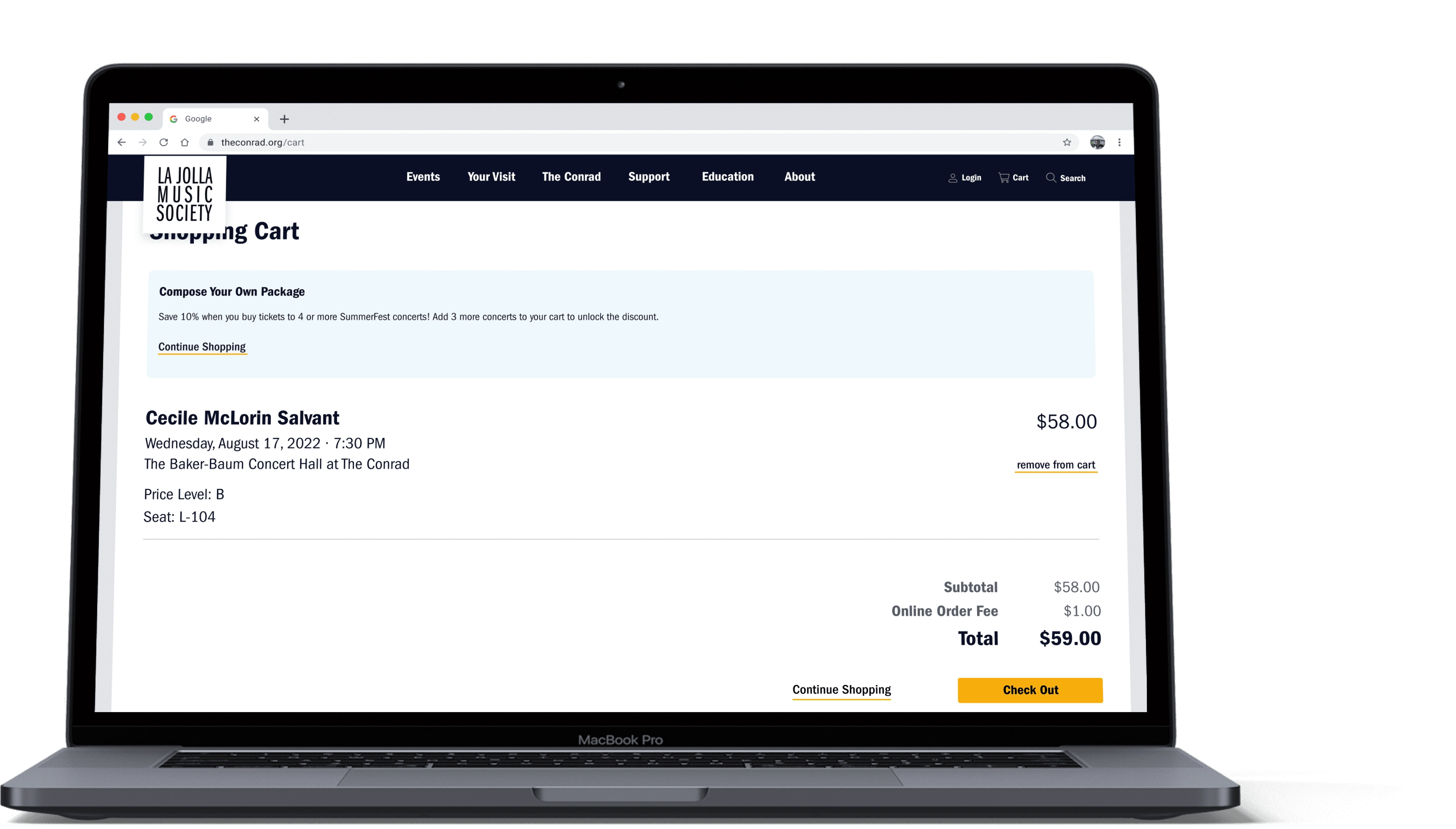
Cart with CYO Banner
Functional Fixedness? Never heard of her
A Fringe benefit of the notification banner
This banner came in handy when we resumed in-person events after COVID shutdowns. We used it to detail event restrictions, safety precautions, and attendance rules for all events.
A new season launch process
With the launch of the new website, online subscriptions, and CYO packages, we needed to revise our season launch SOP. It had previously been a primarily analogue process. The only digital element was updating our event CMS, which populated concerts in the calendar.
As the marketing project manager, I developed the new launch SOP and overhauled the schedule. And as the web designer, I built it all out.
It resonated
Financial impact of the CYO flow
In the first season with CYO, we surpassed subscription sales goals by 68%, over $200,000.
While subscriptions could only be purchased before the start of the performance season, CYO packages could be purchased throughout the season. Non-subscription ticket sales increased by 30% in that first post-launch season, likely thanks to the discount’s duration and the upsells in the notification banner.
We continued to surpass subscription sales goals by over $100,000 for the three subsequent seasons that I worked with LJMS, thanks to “Compose Your Own” packages.
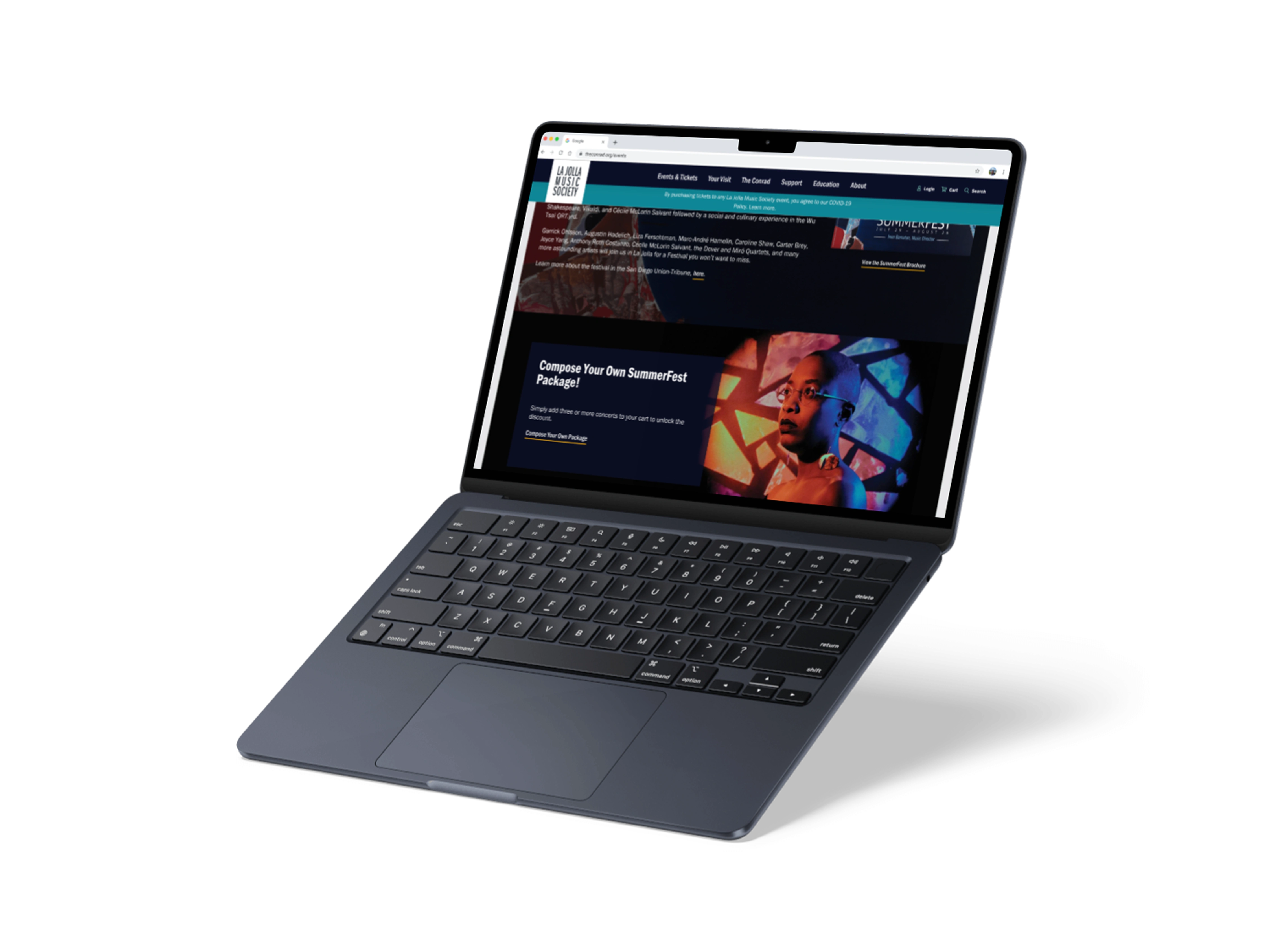
Organizational impact of online subscriptions and the CYO flow
Prior to the project, the box office spent nearly 300 person-hours per annum prepping and booking subscriptions via snail mail and phone for only 120 subscribers. After the launch, more than 60% of subscribers began subscribing online, significantly reducing the burden on the box office.
The increase in patrons who purchased multiple single tickets via the CYO program led to a much larger user group for the marketing department to retarget for future subscription and single-ticket sales.
Improvements to the website and ticketing flows led the majority of single-ticket buyers to start purchasing tickets online too, further reducing the burden on the box office.
What I learned
I took a risk on a new approach that received hesitant buy-in from senior staff, but it ended up a huge success. I learned a lot about office politics, and that empirical data isn’t always enough to persuade senior staff to take a short-term risk for long-term rewards.
I was particularly proud of how well this program performed financially, as well as how much easier and less stressful it made season launches for my coworkers.
Still curious?
Ask me about
How I refined cross-functional communication skills while building LJMS’ gala sign-up and donation flow, which helped exceed fundraising goals by over $100,000 (approx. 29%).
How I led the pivot to streaming educational events and concerts when our 50-year-old chamber music festival was forced online during the early months of COVID.
Like this project
Posted Jul 15, 2025
Redesigned La Jolla Music Society's website, enabling online ticketing and custom packages, exceeding revenue goals by 68%.






